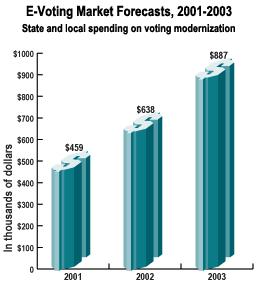ACROSS THE DIGITAL NATION

With Independence Day just behind us, it's time to reassess some of the processes concerning the most fundamental right of every American: the right to vote.
With Independence Day just behind us, it's time to reassess some of the processes concerning the most fundamental right of every American: the right to vote.The debacle of the recent presidential election has magnified an already significant problem. The voting process is marred by outdated systems, inefficient business processes and lack of uniform procedures. Electronic voting has rapidly gained acceptance as a way to resolve some of the problems associated with the process. A number of vendors have recently formed alliances to target this growing area of opportunity. Too often, however, e-voting is narrowly defined as Internet voting. Given that widespread Internet voting is decades away, vendors should look at the opportunities that lie across the entire voting process.XXXSPLITXXX-The application of new voting technologies should be seen as multifaceted. The real opportunities for the vendor community involve the four major steps centered around the voting process:XXXSPLITXXX-Two pieces of major federal legislation are being proposed to allocate matching grants to support modernization of the voting process. The Election Reform Act seeks $400 million in federal matching grants, while the Federal Election Modernization Act allocates $250 million.A handful of states have also made voting modernization a key initiative. Florida, Georgia and Arizona have established plans to upgrade current voting technology as well as identify mechanisms to standardize the voting process. Despite the market environment for change, however, capturing the opportunity within the e-voting marketplace is quite complex.Because the voting process is generally localized, there must be a significant amount of cooperation between local, state and federal initiatives aimed at voting reforms. Undoubtedly, though, state and local governments will begin the modernization.The chart above highlights the market forecasts for e-voting systems over the next three years. In 2001, state and local governments will spend an estimated $459 million on e-voting. This figure will grow annually by 39 percent over the next two years, reaching $887 million by 2003.XXXSPLITXXX-E-voting will continue to be a complex area of vendor opportunity over the next five years. Key vendor recommendations include: XXXSPLITXXX-

Rishi Sood is a principal analyst with Gartner Dataquest in Mountain View, Calif. His e-mail address is rishi.sood@gartner.com.


Rishi Sood
- Registration. Each potential voter must first be registered to vote. Registration represents one of the most immediate opportunities for vendors targeting this market solution. The development of statewide voter registries and data sharing requirements between motor vehicle departments and boards of elections represent two growing areas of development.
- Verification. In order to cast a ballot, voters must first provide identification to verify the voter against the master registry. This process is aimed at reducing fraud and eliminating double-voters. Solutions that can speed online checking by precinct workers and provide statewide coverage would improve this step of the voting process.
- Recording. The most complex and important part of the voting process, recording, consists of two distinct steps: 1. placing a vote; and 2. authenticating the ballot selection (eliminating undervotes and overvotes). There are several obstacles to the immediate overhaul of this cornerstone step of the voting process, such as the digital divide, local control of ballot design and voting machines, and accessibility issues for the disabled.
Given these important issues, this opportunity area may require a longer time horizon. Once resolved, however, the key opportunity in the recording step is to replace the hardware associated with outdated mechanical level machines and punch-card systems. - Reporting. After the voter casts the ballot, the information must be tallied and reported. The key to the reporting process is that the results must be accurate, verifiable and repeatable.
For example, each recount should yield the same results. In many respects, reforms in this area will be dependent upon the technologies chosen to record the vote. Direct record electronic systems represent the most promising solution to resolve the major issues in this step of the process.
By utilizing this e-voting approach, vendors will be able to dissect the portions of the opportunity that are more immediate as well as identify those areas that require certain skill sets (e.g. integration vs. hardware deployment).
- View e-voting as a multidimensional opportunity, with integration opportunities in registration and verification and hardware plays for recording and reporting.
- Segment more immediate areas of opportunity (registration and verification) from more complex areas that may require time to form a consensus (recording and reporting).
- Focus on states with established statewide voting reform initiatives in development rather than piecemeal opportunities at the local level.
Rishi Sood is a principal analyst with Gartner Dataquest in Mountain View, Calif. His e-mail address is rishi.sood@gartner.com.
